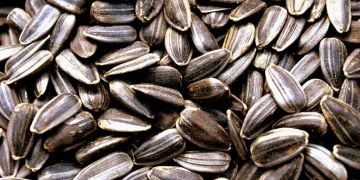Nobody should eat their chia pet. Compared to the seeds, the plant (Salvia hispanica) itself has almost no nutritional value anyway. All the nutrients are in the seeds. The seeds in chia pet products shouldn't be consumed since they weren't packaged for human consumption, but chia seeds are actually extremely healthy and have many vitamins and nutrients essential for a healthy diet.
How and Where Chia Seeds Grow
Chia seeds are native to Guatemala and Mexico where they are used in the production of food. Chia is a flowering mint species of plant. The seeds are the part used as food. They can be ground or used whole in drinks, bread, crackers and puddings.
There's evidence that salvia hispanica was as important as maize as a crop in pre-Columbian times. In Mexico and Guatemala, it's still an essential food ingredient.
The plant grows to three feet tall and has white and purple flowers. The plant is grown almost exclusively for its seeds. The seeds are approximately 1 mm in size.
Chia Seeds Provide Omega 3 Oils
Chia seeds are a great source of omega-3 fatty acids. The seeds are composed of 60 percent Omega-3 fatty acids, which elevates them above other plant-based sources. Vegetarians and vegans benefit from the omega-3s that cannot be obtained in high numbers from other plant sources. The seeds have more omega-3s than salmon. Omega-3s help reduce inflammation and reduce cholesterol.
Important Minerals in Chia Seeds
In each three tablespoon serving, chia seeds have 249 milligrams of calcium. The daily need for calcium is 1,000 milligrams. Calcium helps keep bones strong and healthy. Calcium also reduces the chance of getting osteoporosis as a person ages.
There are 20 milligrams of niacin in chia seeds, which is 20 percent of what a person needs daily. Niacin helps to convert food into energy.
Iron is beneficial to the body. It keeps the blood oxygenated. Chia seeds have a healthy dose of iron per serving; 3 milligrams.
How Chia Seeds are Eaten
When the outer shell of chia seeds come in contact with water they expand and become gel-like. It is often used to replace eggs in baking. Chia seeds are gluten-free, so they can easily be introduced to many recipes. They are an excellent source of fiber containing 5 grams per tablespoon. This makes them a perfect choice to replace eggs in bread, and other foods where a person might need to replace eggs and add more fiber into their diet.
When added to recipes, chia seeds add only 190 calories per serving. This makes them a perfect addition to many foods since they expand and help keep a person's appetite satisfied.
Chia seeds can be added to many food products without altering the taste. Since they don't need to be ground to achieve the benefits, they can be sprinkled on salads and added to most foods. Chia seeds don't have a noticeable effect on taste, so they can be used in yogurt, oatmeal, bread, puddings, crackers and soups.
To soften the chia seeds and achieve a consistency that allows them to be added to liquids, add water or milk to the seeds and let sit for fifteen minutes. Milk and honey can be added to the seeds alone to make a tasty, sweet pudding. They can be added to smoothies.
Chia seeds can be added to most meals to get vitamins and minerals that might not be obtained in the diet in other ways. They are full of protein and fiber too.





